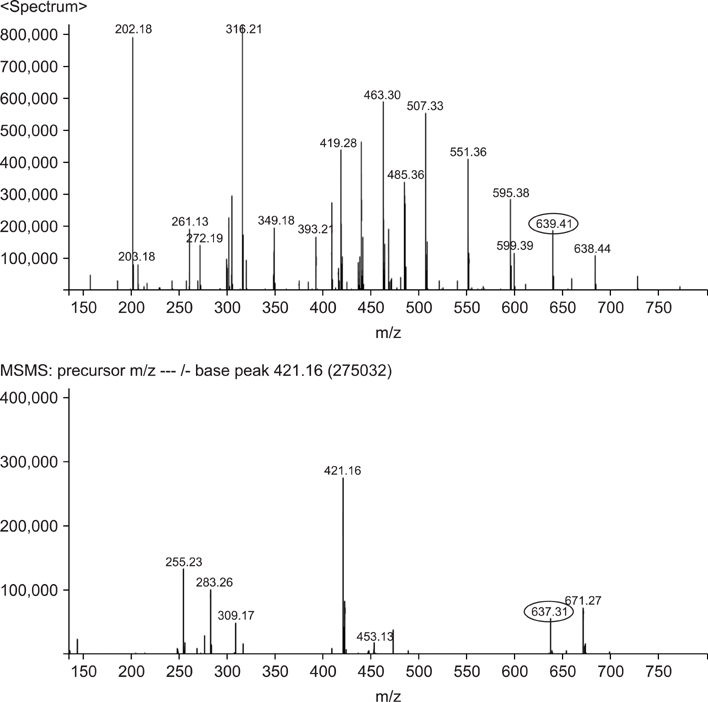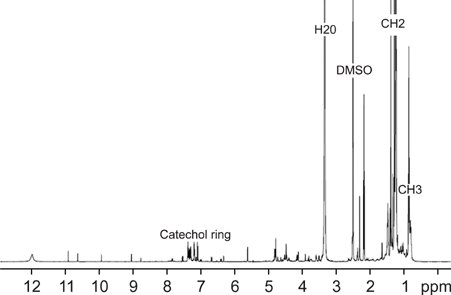Ann Dermatol.
2010 Feb;22(1):16-20. 10.5021/ad.2010.22.1.16.
Polymerized Urushiol of the Commercially Available Rhus Product in Korea
- Affiliations
-
- 1Department of Dermatology, School of Medicine, Ewha Womans University, Seoul, Korea. hychoi@ewha.ac.kr
- 2College of Pharmacy, Catholic University of Daegu, Daegu, Korea.
- KMID: 2172031
- DOI: http://doi.org/10.5021/ad.2010.22.1.16
Abstract
- BACKGROUND
Systemic contact dermatitis commonly occurs with the intake of rhus (boiled chicken with rhus) as a health food and a folk medicine to cure gastrointestinal diseases in Korea. Rhus companies insist they have the technology for rhus detoxification. However, the numbers of systemic allergic contact dermatitis patients, caused by rhus, have not decreased. The principle of present techniques for rhus detoxification is the induction of the polymerization of urushiol, but polymerized urushiol may still have antigenicity, although to a diminished degree. The Korean Food and Drug Administration (KFDA) has a regulation to control urushiol use as a food. However, the laboratory method that KFDA uses for detection of rhus can only detect the urushiol monomer.
OBJECTIVE
We conducted experiments to detect polymerized urushiol in rhus products, which were considered not to include urushiol by the KFDA.
METHODS
Rhus product approved by the KFDA was separated with chloroform. The chloroform fractionation was accomplished on a recycle HPLC system. Four peaks were achieved and evaporated to give an amorphous powder. Each powder was analyzed on a NMR system and mass spectrometer. RESULTS: The material considered to be urushiol dimer, with a 638 molecular weight (MW), was detected in one of the four powders as per the HPLC peaks.
CONCLUSION
We concluded that commercially available rhus product is comprised of material considered to be urushiol dimer. Therefore, even if the antigenicity of the rhus products is low, this product may cause adverse effects and is not completely detoxified.
MeSH Terms
-
Catechols
Chickens
Chloroform
Chromatography, High Pressure Liquid
Dermatitis, Allergic Contact
Dermatitis, Contact
Gastrointestinal Diseases
Food, Organic
Humans
Korea
Medicine, Traditional
Molecular Weight
Polymerization
Polymers
Powders
Rhus
United States Food and Drug Administration
Catechols
Chloroform
Polymers
Powders
Figure
Cited by 1 articles
-
Clinical Features of Systemic Contact Dermatitis Due to the Ingestion of Lacquer in the Province of Chungcheongnam-do
Jung Eun Kim, Sung Yul Lee, Jong Suk Lee, Young Lip Park, Kyu Uang Whang
Ann Dermatol. 2012;24(3):319-323. doi: 10.5021/ad.2012.24.3.319.
Reference
-
1. Park SD. Herb medicine-induced adverse effects in dermatological field. J Korean Med Assoc. 2005. 48:325–332.
Article2. Park SD, Lee SW, Chun JH, Cha SH. Clinical features of 31 patients with systemic contact dermatitis due to the ingestion of Rhus (lacquer). Br J Dermatol. 2000. 142:937–942.
Article3. Won TH, Seo PS, Park SD, Kim DL, Park JH. Clinical features in 147 patients with systemic contact dermatitis due to the ingestion of chicken boiled with Japanease lacquer tree. Korean J Dermatol. 2008. 46:761–768.4. Lopez CB, Kalergis AM, Becker MI, Garbarino JA, De Ioannes AE. CD8+ T cells are the effectors of the contact dermatitis induced by urushiol in mice and are regulated by CD4+ T cells. Int Arch Allergy Immunol. 1998. 117:194–201.
Article5. Kalish RS, Wood JA, LaPorte A. Processing of urushiol (poison ivy) hapten by both endogenous and exogenous pathways for presentation to T cells in vitro. J Clin Invest. 1994. 93:2039–2047.
Article6. Choi HS, Kim MK, Park HS, Yun SE, Mun SP, Kim JS, et al. Biological detoxification of lacquer tree (Rhus verniciflua stokes) stem bark by mushroom species. Food Sci Biotechnol. 2007. 16:935–942.7. McGovern TW, Barkley TM. Botanical dermatology. Int J Dermatol. 1998. 37:321–334.
Article8. Yun SK, Ko KB, Song IM, Choi SP, Ihm CW. Epidemiologic study on systemic contact dermatitis due to ingestion of rhus. Korean J Dermatol. 2002. 40:253–257.9. Oh SH, Haw CR, Lee MH. Clinical and immunologic features of systemic contact dermatitis from ingestion of Rhus (Toxicodendron). Contact Dermatitis. 2003. 48:251–254.
Article10. Xia Z, Miyakoshi T, Yoshida T. Lipoxygenase-catalyzed polymerization of phenolic lipids suggests a new mechanism for allergic contact dermatitis induced by urushiol and its analogs. Biochem Biophys Res Commun. 2004. 315:704–709.
Article11. Harigaya S, Honda T, Rong L, Miyakoshi T, Chen CL. Enzymatic dehydrogenative polymerization of urushiols in fresh exudates from the lacquer tree, Rhus vernicifera DC. J Agric Food Chem. 2007. 55:2201–2208.
Article12. Kawai K, Nakagawa M, Miyakoshi T, Miyashita K, Asami T. Heat treatment of Japanese lacquerware renders it hypoallergenic. Contact Dermatitis. 1992. 27:244–249.
Article
- Full Text Links
- Actions
-
Cited
- CITED
-
- Close
- Share
- Similar articles
-
- Experimental Study on Latent Sensitivity to Rhus Trees
- Immunohistochemical Study on Allergic Contact Dermatitis and Systemic Contact Dermatitis to Urushiol (Rhus verniciflua)
- A Case of Cerebral Infarction Following Ingestion of Urushiol
- Urushiol V Suppresses Cell Proliferation and Enhances Antitumor Activity of 5-FU in Human Colon Cancer Cells by Downregulating FoxM1
- A Case of Systemic Allergic Contact Dermatitis with Erythema Multiforme-like Eruptions Due to Urushiol




